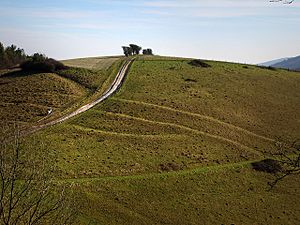Beacon Hill, West Sussex facts for kids
Beacon Hill, also known as Harting Beacon, is an ancient hillfort located on the South Downs in West Sussex, southern England. It's found near the villages of Elsted and Treyford. This special historical site is protected as a Scheduled Ancient Monument.
The fort was first built a very long time ago, during the late Bronze Age, between 800 and 500 BC. Its defenses were even updated later, during the late Iron Age. Beacon Hill is quite large, covering about 10 hectares (which is like 25 acres). It stretches about 400 meters (1,300 feet) from east to west and 500 meters (1,600 feet) from north to south. Experts studied the fort in the late 1940s and 1970s to learn more about it. Other old ditches on nearby hills might have been outer defenses for the fort. Besides the Bronze Age remains, the area also has an Anglo-Saxon burial mound and the ruins of an old telegraph station from the late 1700s.
What is Beacon Hill?
This hillfort sits right on top of a hill. It was protected by a single rampart (a large bank of earth) and a flat-bottomed ditch. The rampart was originally made stronger with timber, using wooden walls on both the inside and outside. The rampart itself was built from a mix of soil and chalk. It's best preserved on the south side of the fort. On the east and west sides, the rampart has worn down, and the ditch has filled in, forming a flat area.
The fort is roughly rectangular in shape. It had an entrance on its west side. When archaeologists dug there, they found that a large wooden gate once stood in this entrance. They also found two incomplete gold rings! It's possible there was another entrance on the northeast side, where a modern path now crosses the old rampart. Inside the fort, there weren't many features found, except for traces of small structures with four or six posts. These are thought to have been raised granaries, used for storing grain.
Other Cool Discoveries
Inside the fort area, there was once a small bowl barrow, which is a type of burial mound. It was about 0.6 meters (2 feet) high and 7.5 meters (25 feet) wide. Sadly, modern farming has destroyed this mound. It was located in the southeastern part of the fort. When archaeologists dug there in 1976, they found a burial, though it had been disturbed by earlier explorers. This burial mound was identified as an Anglo-Saxon hlaew, which means a burial mound from the Anglo-Saxon period.
Also within the fort are the remains of a telegraph station from the late 1700s. You can still see rectangular earthworks and foundations made of stone, concrete, and brick. This station was part of a semaphore line that sent messages between Portsmouth and London using signals.
There are also Cross dykes (old ditches and banks) on the ridges to the east and west of Beacon Hill. These are thought to be outer defenses connected to the fort. When Harting Beacon was no longer used, it might have been replaced by another nearby Iron Age hillfort called Torberry Hill. This idea is supported by what we know about when both sites were used.


